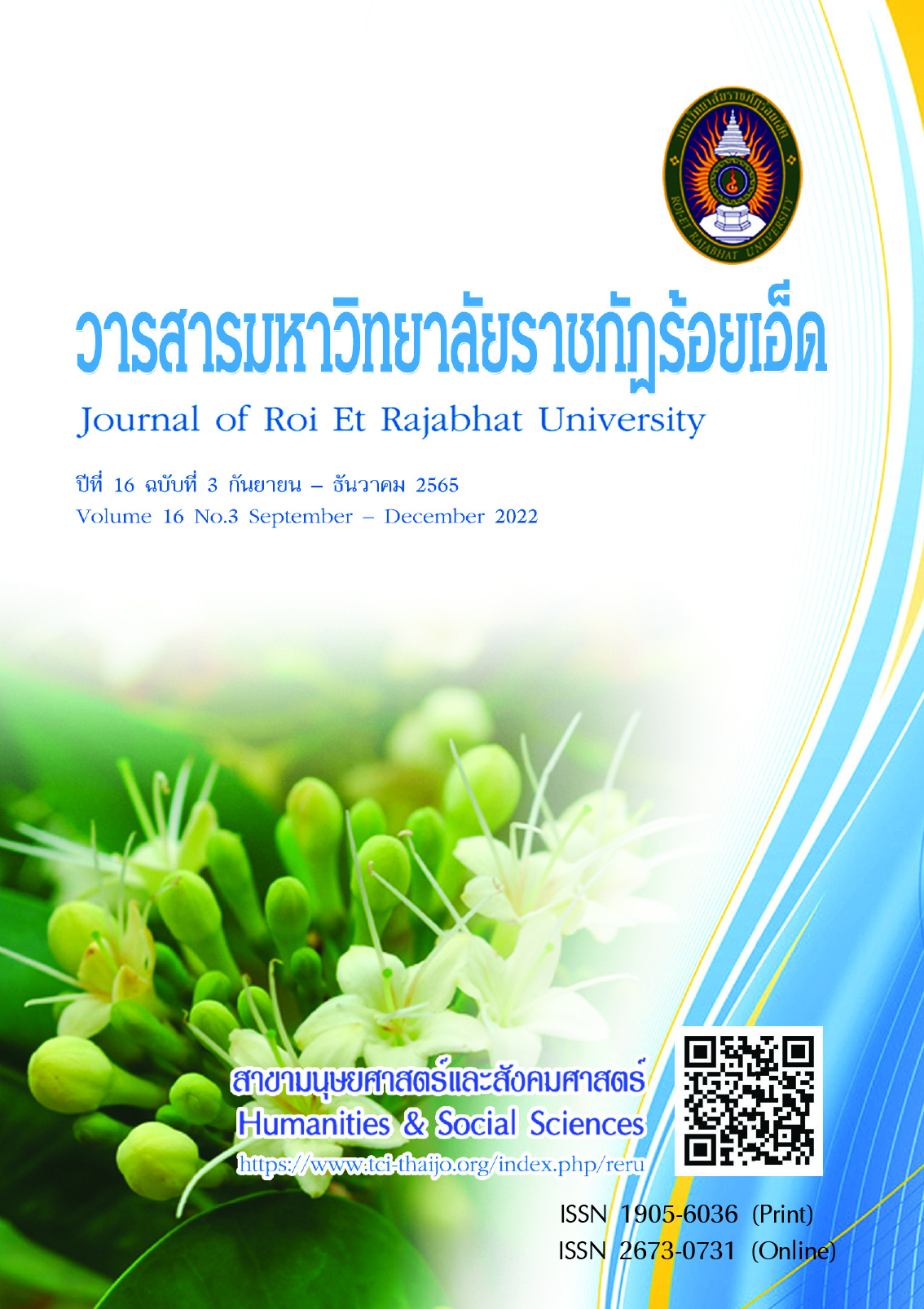Development Problem-Solving Ability by Using Problem-Based Learning Activities Blended with Mind Mapping Technique for Grade 4 Students
Keywords:
Problem solving ability, Problem-based learning, Mind mappingAbstract
This research had purpose to develop problem-solving abilities by using problem-based learning activities blended with mind mapping techniques of grade 4 students. The target group used in this research was the grade 4 students. The target group included 25 students at Sahamitr Pittaya School in the 2nd semester of the academic year 2020. The research instruments were learning management plan using problem-based learning activity blended with mind mapping technique, The problem-solving ability plan, behavioral observation form and reflective assessment form for learning management outcomes. Research results consisted of 3 operating cycles. The statistics used in the data analysis were mean, standard deviation, and percentage. The results of the research found that.
Cycle 1, the students scored 70% of the problem solving ability through the specified criteria for 5 students, representing 20 percent of the total number of students. And there were 20 students who did not pass the criteria of the total number of students. It was found that the researcher will focus on students to participate in answering questions conceptualization There were discussions of various issues together. Classes were organized in groups. Students practice their ability to solve problems on their own and work with others. to understand problems from various situations in daily life.
Cycle 2, students had the ability to solve problems through the threshold of 70 percent of
20 people representing 80 percent of the total number of students. And there were 5 students who did not pass the criteria of the total number of students. It was found that the teachers gave importance to creating an atmosphere, encouraging, giving advice and giving students the opportunity to think and not feel pressured.
Cycle 3, 25 students achieved a score of problem solving ability through the specified criteria of 70 percent, representing 100 percent of the total number of students. And when separating the results of the assessment of problem solving abilities by each aspect, it was found that 93.33 percent of students passed the criteria on the ability to identify problems, 93.33 percent of the students who passed the criteria in analyzing problems. The proposed solution had 86.67 percent of students passing the criteria and the ability to verify results. There were 94.67 percent of students who passed the criteria found that they had skills in working together. have a good relationship with oneself and others in the presentation skills of associative order Summarize the body of knowledge yourself to reflect learning from experiences or situations.
References
กนิษฐกานต์ เบญจพลาภรณ์. (2561). การวิจัยเชิงปฏิบัติการเพื่อพัฒนาการรู้วิทยาศาสตร์โดยการจัดการเรียนรู้แบบใช้ปัญหาเป็นฐาน เรื่องปริมาณสารสัมพันธ์ สำหรับนักเรียนชั้นมัธยมศึกษาปีที่ 4. วิทยานิพนธ์ ศึกษาศาสตรมหาบัณฑิต สาขาวิชาเคมี. พิษณุโลก: มหาวิทยาลัยนเรศวร.
กระทรวงศึกษาธิการ. (2561). มาตรฐานการเรียนรู้และตัวชี้วัดฯ ตามหลักสูตรแกนกลางการศึกษาขั้นพื้นฐาน ฉบับปรับปรุง พ.ศ. 2560. กรุงเทพฯ: กระทรวงศึกษาธิการ.
ชุติมา สรรเสริญ. (2560). การพัฒนาความสามารถการเรียนรู้วิชาวิทยาศาสตร์โดยใช้ปัญหาเป็นฐาน. วิทยานิพนธ์ ศึกษาศาสตรมหาบัณฑิต สาขาวิชาหลักสูตรและการสอน. กรุงเทพฯ: มหาวิทยาลัยธุรกิจบัณฑิตย์.
ประมวล อุทัยแสง. (2563). การพัฒนารูปแบบการเรียนการสอนเพื่อส่งเสริมความสามารถในการแก้ปัญหาทางคณิตศาสตร์ สำหรับนักเรียนชั้นมัธยมศึกษาปีที่ 3. วารสารมหาวิทยาลัยราชภัฏร้อยเอ็ด, 14(2), 63–75.
ประสาท เนืองเฉลิม. (2558). การเรียนวิทยาศาสตร์ในศตวรรษที่ 21 (วิทยาศาสตร์ การศึกษาและการสอน). กรุงเทพฯ: จุฬาลงกรณ์มหาวิทยาลัย.
ปรียานุช พรหมภาสิต. (2557). สร้างเกลียวความรู้พัฒนาการเรียนการสอนแบบ Problem based Learning : PBL. ศึกษาศาสตรมหาบัณฑิต สาขาวิชาหลักสูตรและการสอน. กำแพงเพชร: มหาวิทยาลัยราชภัฏกำแพงเพชร.
พิมพ์ใจ เกตุการณ์, สพลณภัทร์ ศรีแสนยงค์ และสมศิริ สิงห์ลพ. (2558). ผลการจัดการเรียนรู้โดยใช้ปัญหาเป็นฐาน เพื่อพัฒนาผลสัมฤทธิ์ทางการเรียนวิชาวิทยาศาสตร์ ความสามารถในการแก้ปัญหา และเจตคติทางวิทยาศาสตร์ ของนักเรียนชั้นประถมศึกษาปีที่ 6. วารสารศึกษาศาสตร์ มหาวิทยาลัยนเรศวร, 19(1), 77-89.
พระครูสังวรสุดกิจ. (2553). ผลการจัดการเรียนโดยใช้แผนผังความคิด (Mind mapping) เพื่อพัฒนาทักษะการคิดของนิสิตที่ศึกษารายวิชาศาสนากับรัฐศาสตร์. วิทยานิพนธ์ ศึกษาศาสตรมหาบัณฑิต สาขาวิชารัฐประศาสนศาสตร์ วิทยาเขตแพร่. แพร่: มหาจุฬาลงกรณราชวิทยาลัย.
ภิญญาภัสส์ ทิพย์โยธา. (2562). การพัฒนากิจกรรมการเรียนรู้การเขียนเชิงสร้างสรรค์โดยใช้แผนผังความคิดกลุ่มสาระการเรียนรู้ภาษาไทย ชั้นประถมศึกษาปีที่ 6. ครุศาสตรมหาบัณฑิต สาขาวิชาหลักสูตรและการเรียนการสอน. มหาสารคาม: มหาวิทยาลัยราชภัฏมหาสารคาม.
มัสยมาศ ด่านแก้ว. (2557). การศึกษาความสามารถในการแก้ปัญหาและผลสัมฤทธิ์ทางการเรียนของนักเรียนชั้นมัธยมศึกษาปีที่ 2 เรื่องระบบร่างกายมนุษย์และสัตว์โดยใช้การจัดการเรียนรู้แบบใช้ปัญหาเป็นฐาน. วิทยานิพนธ์ ศึกษาศาสตรมหาบัณฑิต สาขาวิชาวิทยาศาสตร์ศึกษา. ขอนแก่น: มหาวิทยาลัยขอนแก่น.
โรงเรียนสหมิตรพิทยา. (2563). รายงานการประเมินตนเองของสถานศึกษา โรงเรียนสหมิตรพิทยา (Self-Assessment Report) ปีการศึกษา 2562. ร้อยเอ็ด: โรงเรียนสหมิตรพิทยา.
วรัชญา สำราญรมย์. (2557). การศึกษาความสามารถด้านการอ่านภาษาอังกฤษเพื่อความเข้าใจและการคิดวิเคราะห์ของนักเรียนชั้นประถมศึกษาปีที่ 6 ด้วยการใช้การจัดการเรียนรูแบบ SQ4R ร่วมกับเทคนิคแผนผังความคิด. วิทยานิพนธ์ ศึกษาศาสตรมหาบัณฑิต สาขาวิชาหลักสูตรและการสอน. ขอนแก่น: มหาวิทยาลัยขอนแก่น.
ศิริวรรณ หล้าคอม. (2556). การพัฒนาความสามารถในการแก้ปัญหาและผลสัมฤทธิ์ทางการเรียนเรื่องการอนุรักษ์ทรัพยากรธรรมชาติและสิ่งแวดล้อมของนักเรียนชั้นมัธยมศึกษาที่ 2 โดยการจัดกิจกรรมการเรียนรู้แบบใช้ปัญหาเป็นฐาน. วิทยานิพนธ์ ศึกษาศาสตรมหาบัณฑิต สาขาวิชาหลักสูตรและการสอน. ขอนแก่น: มหาวิทยาลัยขอนแก่น.
สุคนธ์ สินธพานนท์. (2555). พัฒนาทักษะการคิดตามแนวปฏิรูปการศึกษา. กรุงเทพฯ: 9119 เทคนิคพริ้นติ้ง.
สุพรรษา บุตตเขียว และสิทธิพล อาจอินทร์. (2560). การศึกษาความสามารถในการแก้ปัญหาทางวิทยาศาสตร์ และเจตคติทางวิทยาศาสตร์ของนักเรียนชั้นมัธยมศึกษาปีที่ 1 โดยการจัดการเรียนรู้แบบใช้ปัญหาเป็นฐานร่วมกับเทคนิคแผนผังความคิด. วารสารศึกษาศาสตร์ ฉบับวิจัยบัณฑิตศึกษา มหาวิทยาลัยขอนแก่น, 11(2), 5-12.
อิทธิพัทธ์ ศุภรัตนาวงศ์. (2558). การศึกษาผลสัมฤทธิ์ทางการเรียน และความสามารถในการแก้ปัญหา เรื่องสังคมไทย ของนักเรียนชั้นมัธยมศึกษาปีที่ 3 ด้วยการเรียนรู้แบบผสมผสานโดยใช้ปัญหาเป็นฐานร่วมกับสังคมออนไลน์. วิทยานิพนธ์ ศึกษาศาสตรมหาบัณฑิต สาขาวิชาการสอนสังคมศึกษา. กรุงเทพฯ: มหาวิทยาลัยศิลปากร.
Gagne, R. M. (1970). The Condition of Learning (2nd ed.). New York: Holy Rinehart and Winstin lnc.
Quellmalz, E. S. (1985). Needed: Netter methods for testing higher-order thinking skills. Education Leadership, 43(2), 28-34.
Sinthaphanon et al. (2012). Developing thinking skills along to educational reform. Bangkok: 9119 Techniquesprinting.
Tony, B. (1991). Use Both Side of Your Brain. New York: Penquin Group.
Weir, J. J. (1974). Problem Solving is Everybody is Problem. The Science Teacher, 9(4), 16-18.
Downloads
Published
How to Cite
Issue
Section
License
Copyright (c) 2022 Roi Et Rajabhat University

This work is licensed under a Creative Commons Attribution-NonCommercial-NoDerivatives 4.0 International License.
บทความที่ได้รับการตีพิมพ์เป็นลิขสิทธิ์ของวารสารมหาวิทยาลัยราชภัฎร้อยเอ็ด
ข้อความที่ปรากฏในบทความแต่ละเรื่องในวารสารวิชาการเล่มนี้เป็นความคิดเห็นส่วนตัวของผู้เขียนแต่ละท่านไม่เกี่ยวข้องกับมหาวิทยาลัยราชภัฎร้อยเอ็ด และคณาจารย์ท่านอื่นๆในมหาวิทยาลัยฯ แต่อย่างใด ความรับผิดชอบองค์ประกอบทั้งหมดของบทความแต่ละเรื่องเป็นของผู้เขียนแต่ละท่าน หากมีความผิดพลาดใดๆ ผู้เขียนแต่ละท่านจะรับผิดชอบบทความของตนเองแต่ผู้เดียว





